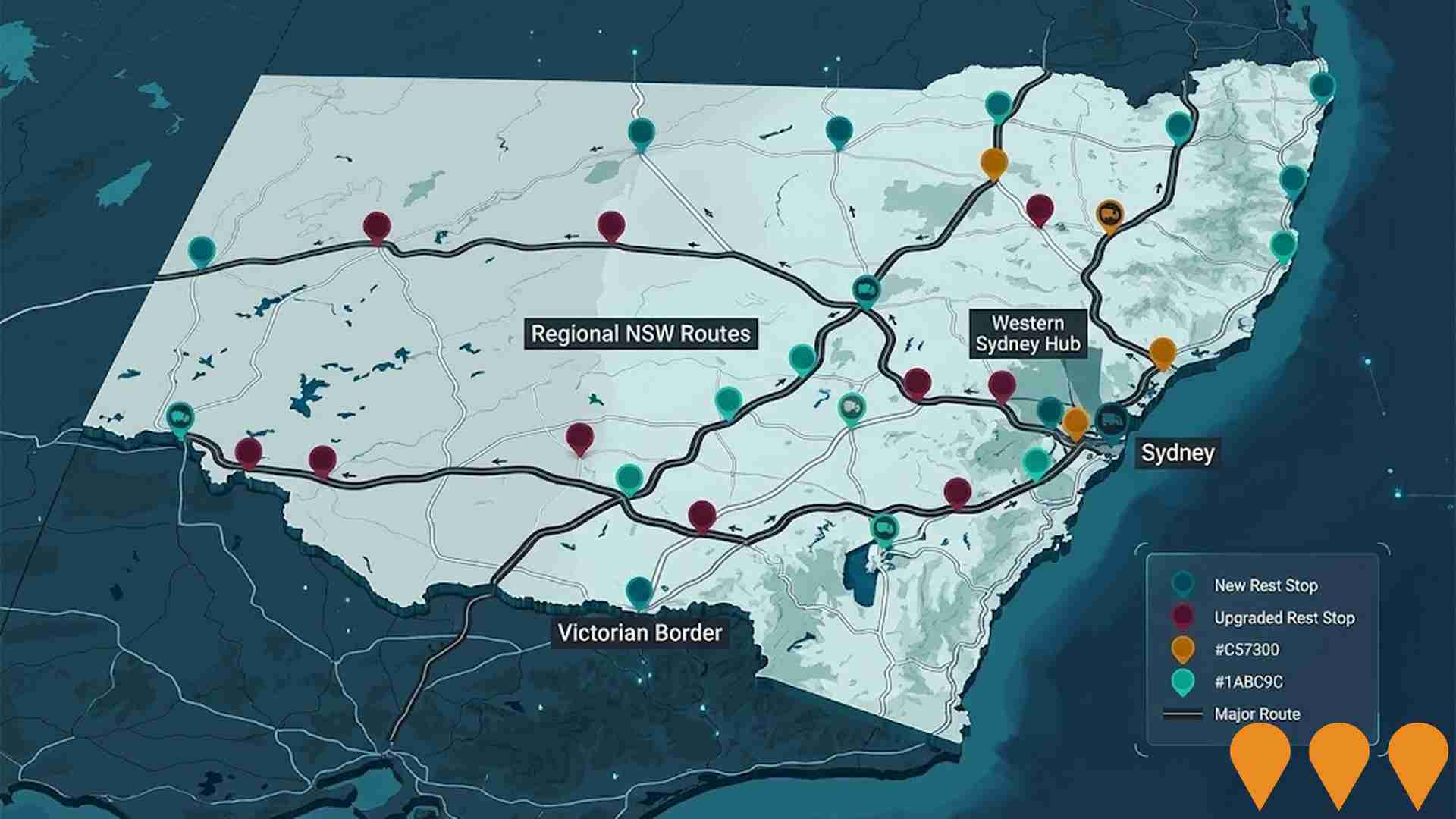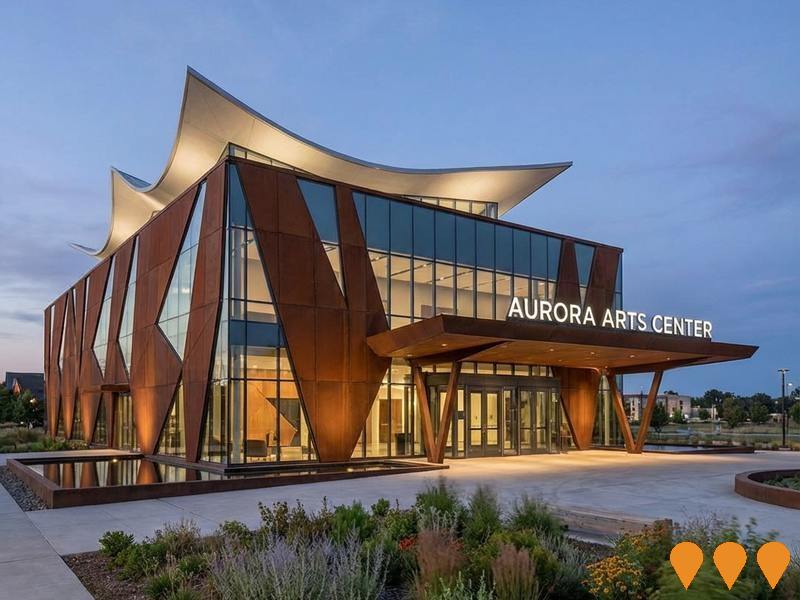Chart Color Schemes
est. as @ -- *
ABS ERP | -- people | --
2021 Census | -- people
Sales Activity
Curious about local property values? Filter the chart to assess the volume and appreciation (including resales) trends and regional comparisons, or scroll to the map below view this information at an individual property level.
Find a Recent Sale
Sales Detail
Population
Chapman is positioned among the lower quartile of areas assessed nationally for population growth based on AreaSearch's assessment of recent, and medium term trends
Chapman's population, as per AreaSearch's analysis, is approximately 2,875 as of August 2025. This represents an increase of 8 people, a 0.3% rise from the 2021 Census figure of 2,867 inhabitants. The growth was inferred from the estimated resident population of 2,873 in June 2024 and an additional 16 validated new addresses since the Census date. This results in a population density ratio of 1,545 persons per square kilometer, higher than the average across national locations assessed by AreaSearch. Chapman's 0.3% growth since the census is within 0.2 percentage points of the SA3 area (0.5%), indicating competitive growth fundamentals. Overseas migration was the primary driver of population growth in recent periods.
AreaSearch uses ABS/Geoscience Australia projections for each SA2 area, released in 2024 with a base year of 2022. For areas not covered and years post-2032, age group growth rates from the ACT Government's SA2 area projections are adopted, using 2022 as the base year. Projections indicate an overall population decline by 349 persons in Chapman by 2041. However, specific age cohorts are expected to grow, notably the 85 and over age group, projected to increase by 37 people.
Frequently Asked Questions - Population
Development
Residential development activity is lower than average in Chapman according to AreaSearch's national comparison of local real estate markets
Chapman has recorded approximately six residential properties granted approval each year. Over the past five financial years, from FY21 to FY25, around thirty homes were approved, with zero approved so far in FY26.
On average, 2.7 new residents per year have been gained for each dwelling built over these five financial years, indicating solid demand that supports property values. This year, $747,000 in commercial approvals have been registered, suggesting a predominantly residential focus. Compared to the Australian Capital Territory, Chapman has 12.0% less new development per person and ranks among the 26th percentile of areas assessed nationally, implying somewhat limited buyer options while strengthening demand for established homes. This activity is lower than national averages, reflecting market maturity and possible development constraints.
New building activity consists of 60.0% detached dwellings and 40.0% attached dwellings, with a growing mix of townhouses and apartments offering options across different price points, from family homes to more affordable compact living. This shift represents a notable change from the area's existing housing composition, currently at 89.0% houses, indicating decreasing availability of developable sites and reflecting changing lifestyles and demand for diverse, affordable housing options. With population expected to remain stable or decline in Chapman, there should be reduced pressure on housing, potentially creating opportunities for buyers.
Frequently Asked Questions - Development
Infrastructure
Chapman has moderate levels of nearby infrastructure activity, ranking in the 40thth percentile nationally
Changes in local infrastructure significantly affect an area's performance. AreaSearch has identified zero projects that could potentially impact this region. Notable initiatives include Fetherston Weston, Molonglo Group Centre to Town Centre Transition, Canberra Hospital Master Plan, and Deakin Private Hospital, with the following list detailing those most relevant:.
Professional plan users can use the search below to filter and access additional projects.
INFRASTRUCTURE SEARCH
 Denotes AI-based impression for illustrative purposes only, not to be taken as definitive under any circumstances. Please follow links and conduct other investigations from the project's source for actual imagery. Developers and project owners wishing us to use original imagery please Contact Us and we will do so.
Denotes AI-based impression for illustrative purposes only, not to be taken as definitive under any circumstances. Please follow links and conduct other investigations from the project's source for actual imagery. Developers and project owners wishing us to use original imagery please Contact Us and we will do so.
Frequently Asked Questions - Infrastructure
Low and Mid-Rise Housing Policy
State-wide NSW planning reforms via amendments to the State Environmental Planning Policy to enable more diverse low and mid-rise housing (dual occupancies, terraces, townhouses, manor houses and residential flat buildings up to 6 storeys) in well-located areas within 800 m of selected train, metro and light-rail stations and town centres. Stage 1 (dual occupancies in R2 zones statewide) commenced 1 July 2024. Stage 2 (mid-rise apartments, terraces and dual occupancies near stations) commenced 28 February 2025. Expected to facilitate up to 112,000 additional homes over the next five years.
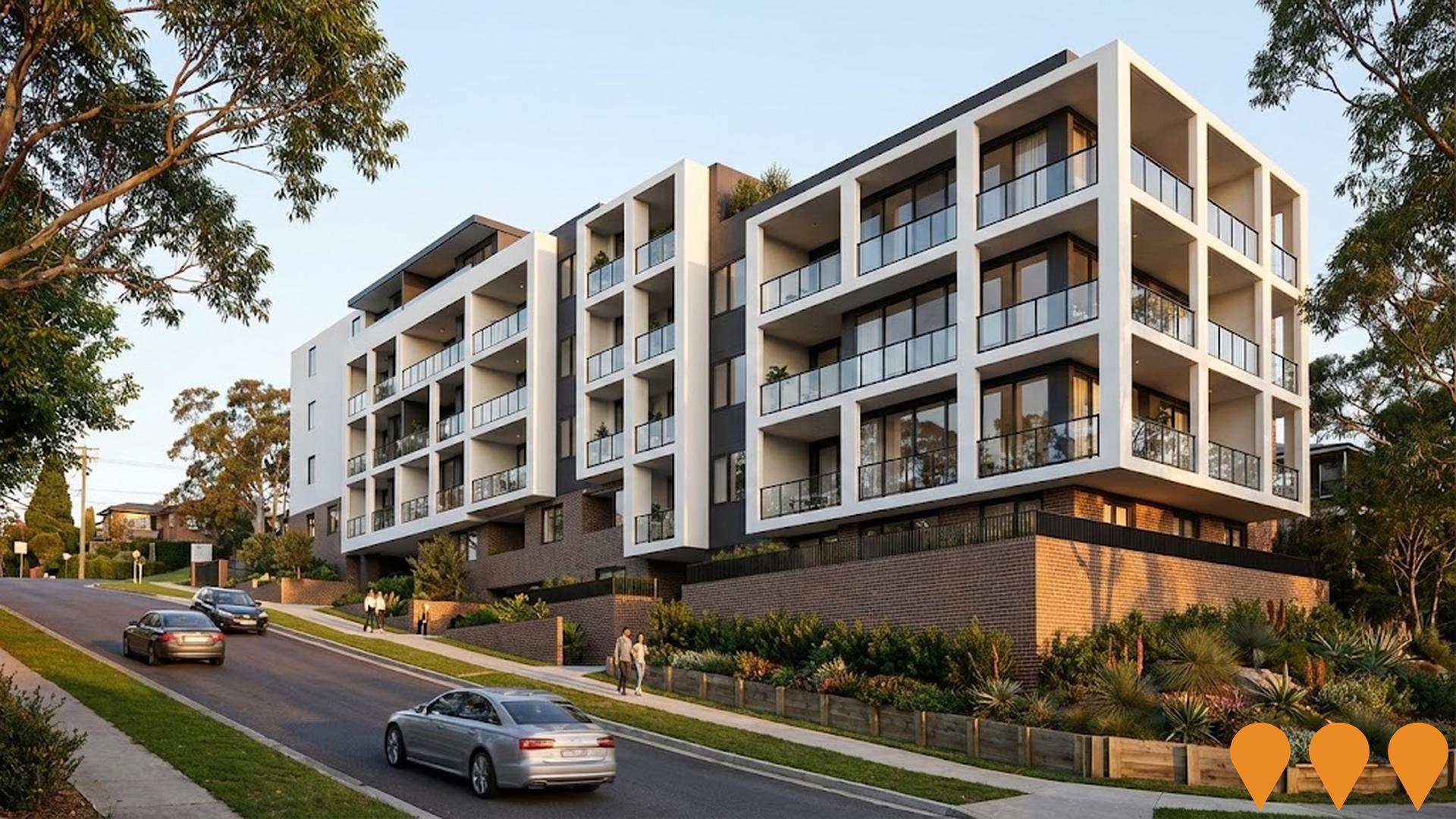
Canberra Hospital Master Plan
Long-term transformation of Canberra Hospital campus (2021-2041). The new Critical Services Building (Building 5) opened in 2023. Multiple stages are now in construction or detailed planning, including SPIRE Stage 1 (new emergency, surgical and intensive care facilities) and ongoing campus renewal works to deliver modern clinical facilities.

Canberra Light Rail Stage 4 - Woden to Tuggeranong
Proposed extension of Canberra's light rail network from Woden Town Centre south to Tuggeranong Town Centre via Mawson and the Athllon Drive corridor. This future stage aims to complete the north-south radial mass transit spine, connecting major residential, employment and activity centres while supporting bus, cycling, walking and private vehicle integration.
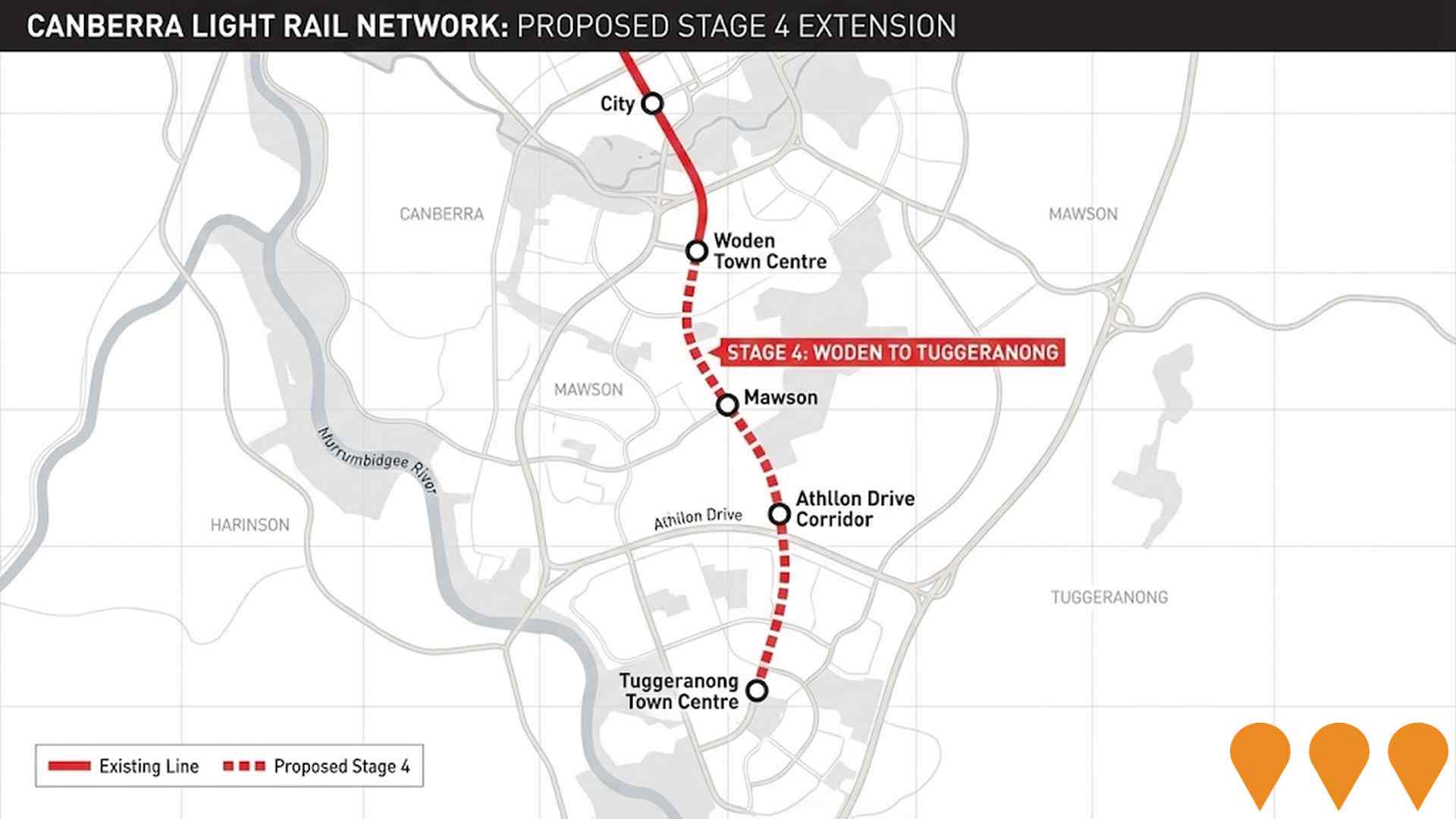
Molonglo Group Centre to Town Centre Transition
Transition of Molonglo Group Centre to Town Centre status to accommodate 70,000+ residents by 2050. Will include college, library, community centre, transport interchange and major commercial centre development.
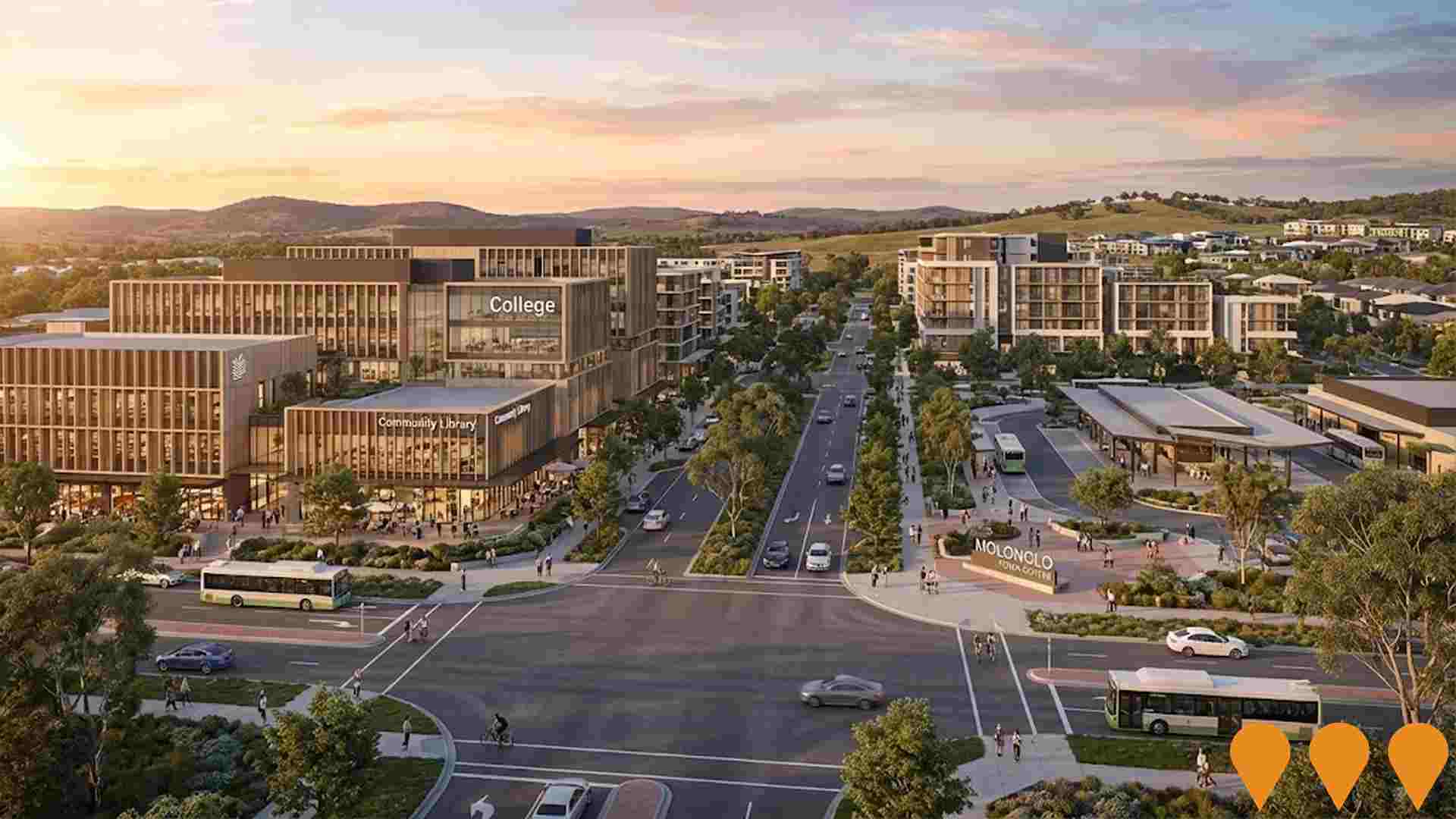
Enhanced bus and light rail corridors (Belconnen & Queanbeyan to Central Canberra)
ACT is progressing an integrated program to enhance high-frequency bus and future light rail corridors that link Belconnen and Queanbeyan with central Canberra. Light Rail Stage 2A (City to Commonwealth Park) commenced construction in early 2025 with services targeted from 2028, while planning and approvals continue for Stage 2B to Woden. The ACT Government has acknowledged and is planning upgrades for the Belconnen-to-City bus corridor as groundwork for a future east-west light rail Stage 3, and is coordinating cross-border public transport initiatives with NSW through the Queanbeyan Region Integrated Transport Plan and the ACT-NSW MoU for Regional Collaboration.
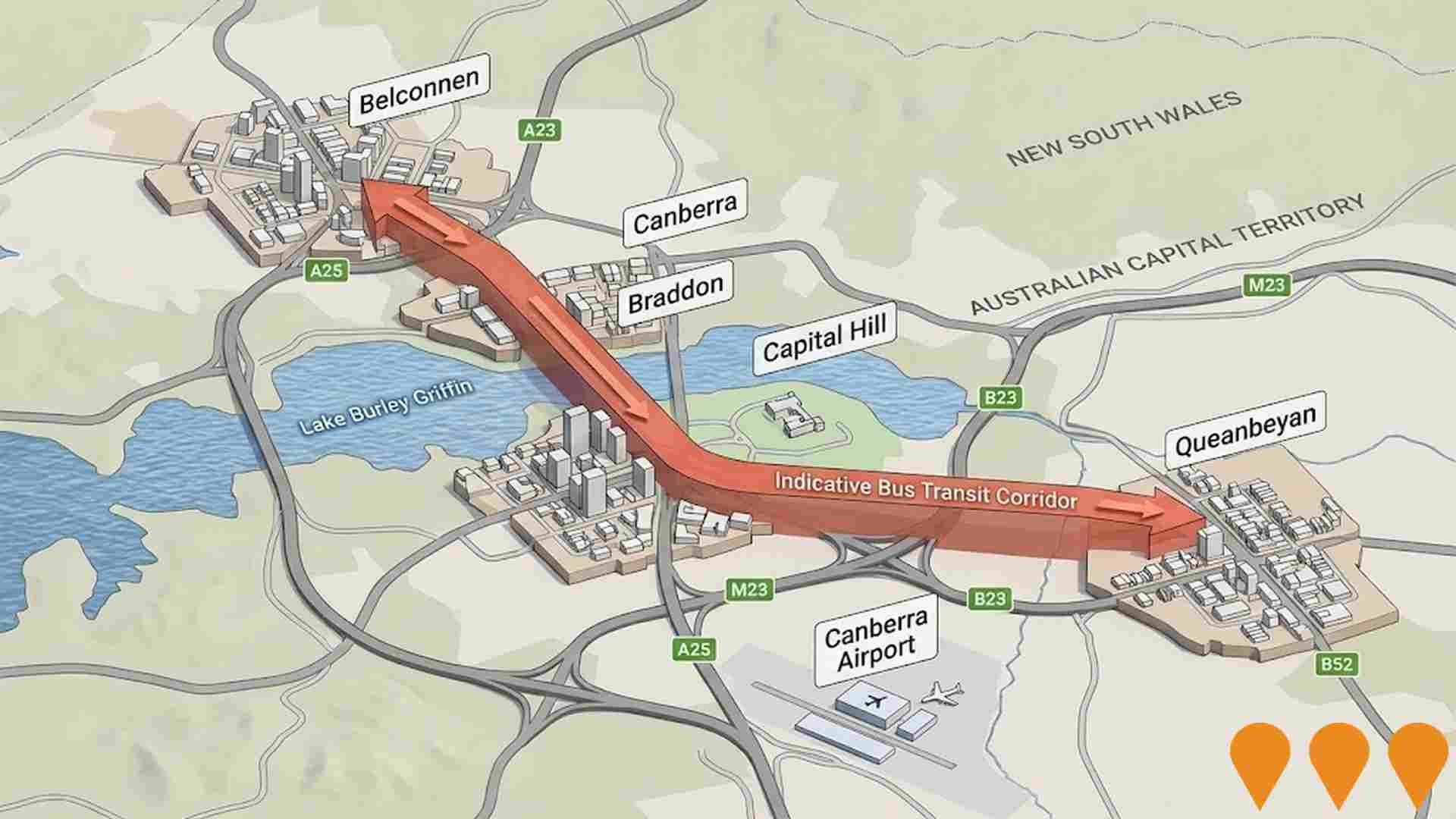
HumeLink
HumeLink is a new 500kV transmission line project connecting Wagga Wagga, Bannaby, and Maragle, spanning approximately 365 km. It includes new or upgraded infrastructure at four locations and aims to enhance the reliability and sustainability of the national electricity grid by increasing the integration of renewable energy sources such as wind and solar.
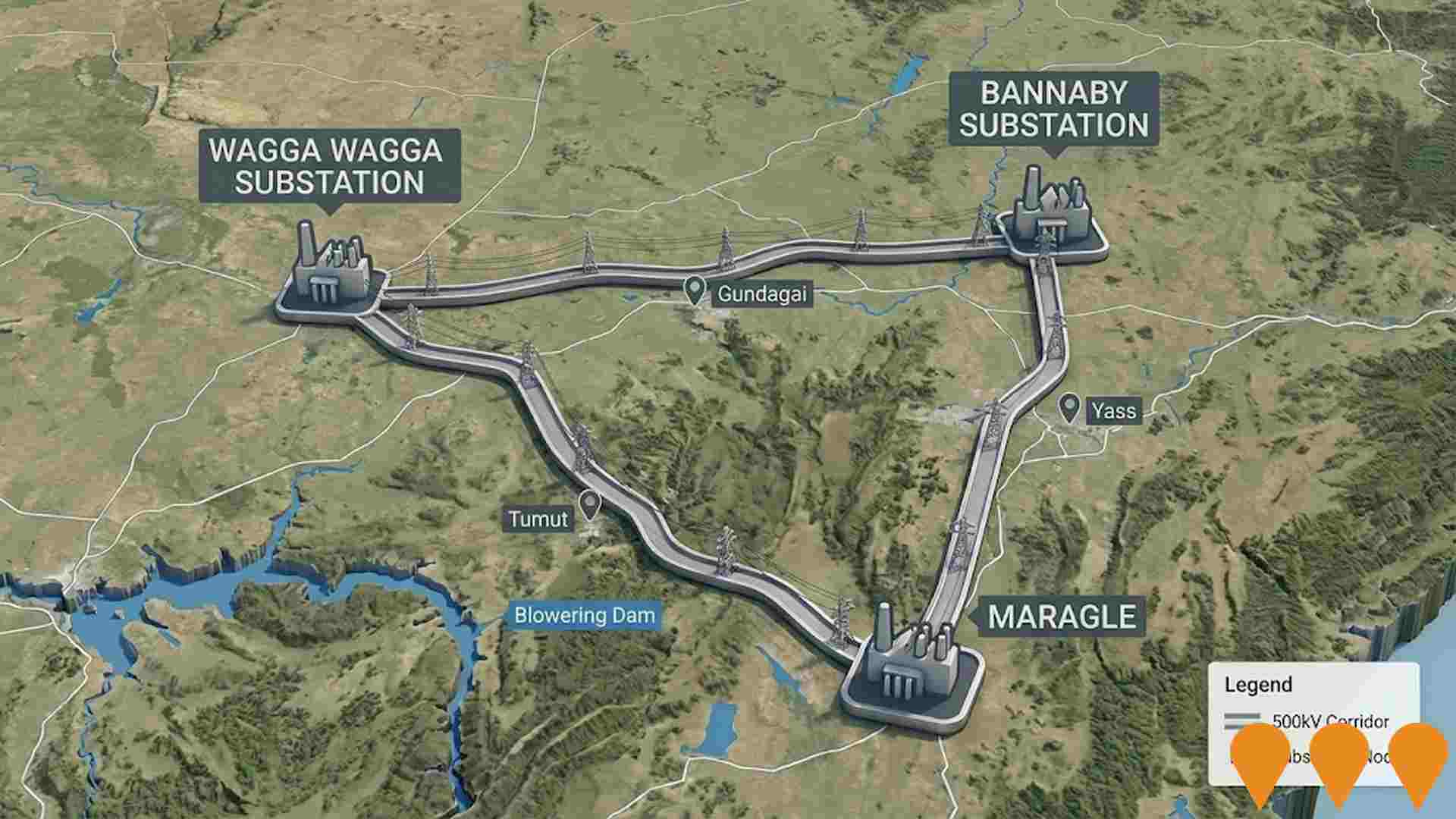
Queanbeyan Regional Integrated Transport Plan
Comprehensive transport planning initiative with 64 key actions for next 10 years. Addresses road safety, active transport connectivity, public transport availability, and future transport needs. Improved connections between Queanbeyan and ACT.
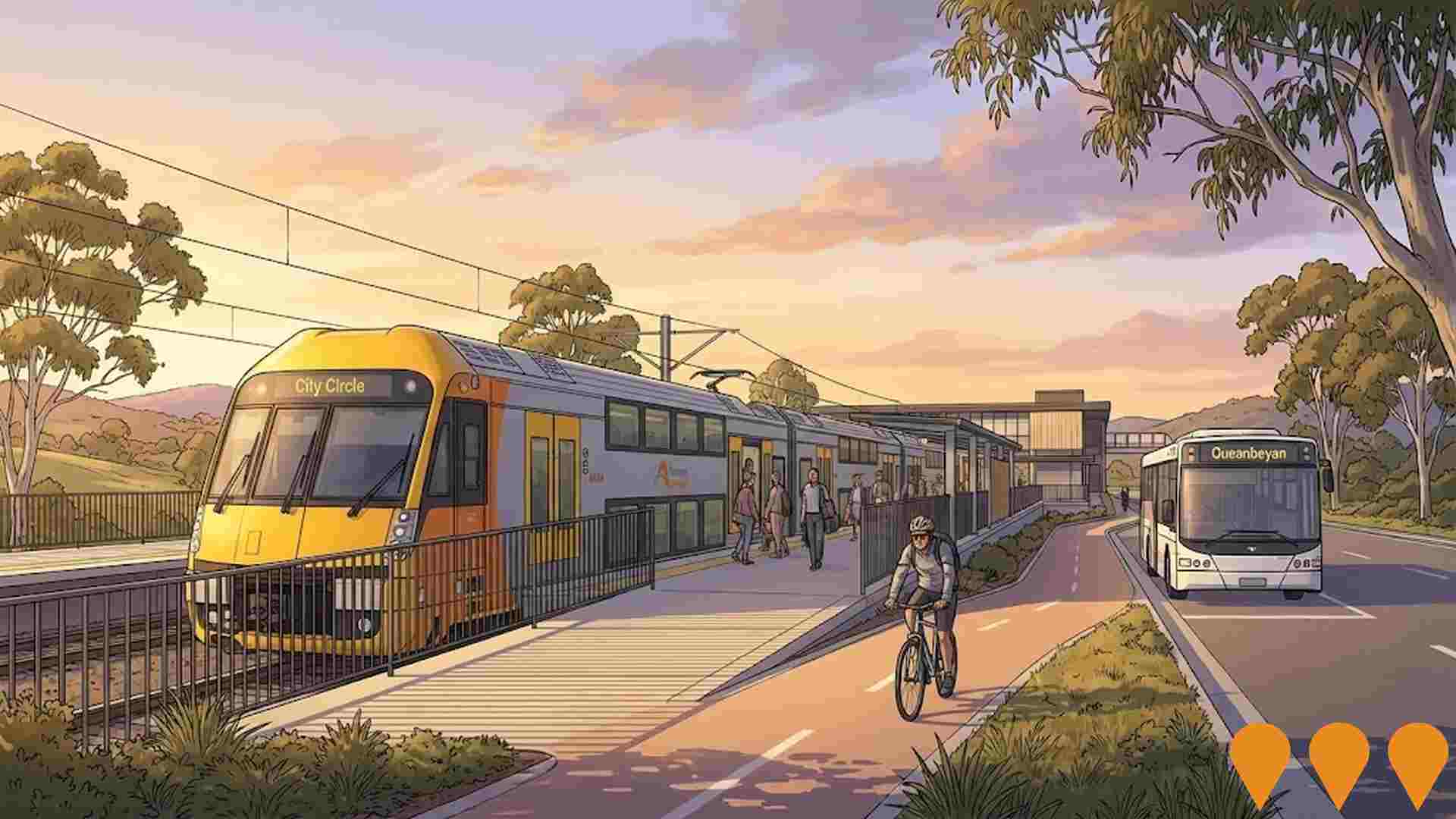
Big Canberra Battery (Williamsdale BESS)
A 250 MW / 500 MWh battery energy storage system at Williamsdale in southern Canberra, delivered by Eku Energy as Stream 1 of the ACT Government's Big Canberra Battery. Construction commenced in November 2024 with partners CPP and Tesla supplying Megapack systems. The asset will connect to Evoenergy's 132 kV network near the Williamsdale substation to provide two hours of dispatchable power, grid services and reliability for the ACT. Target operations in 2026.
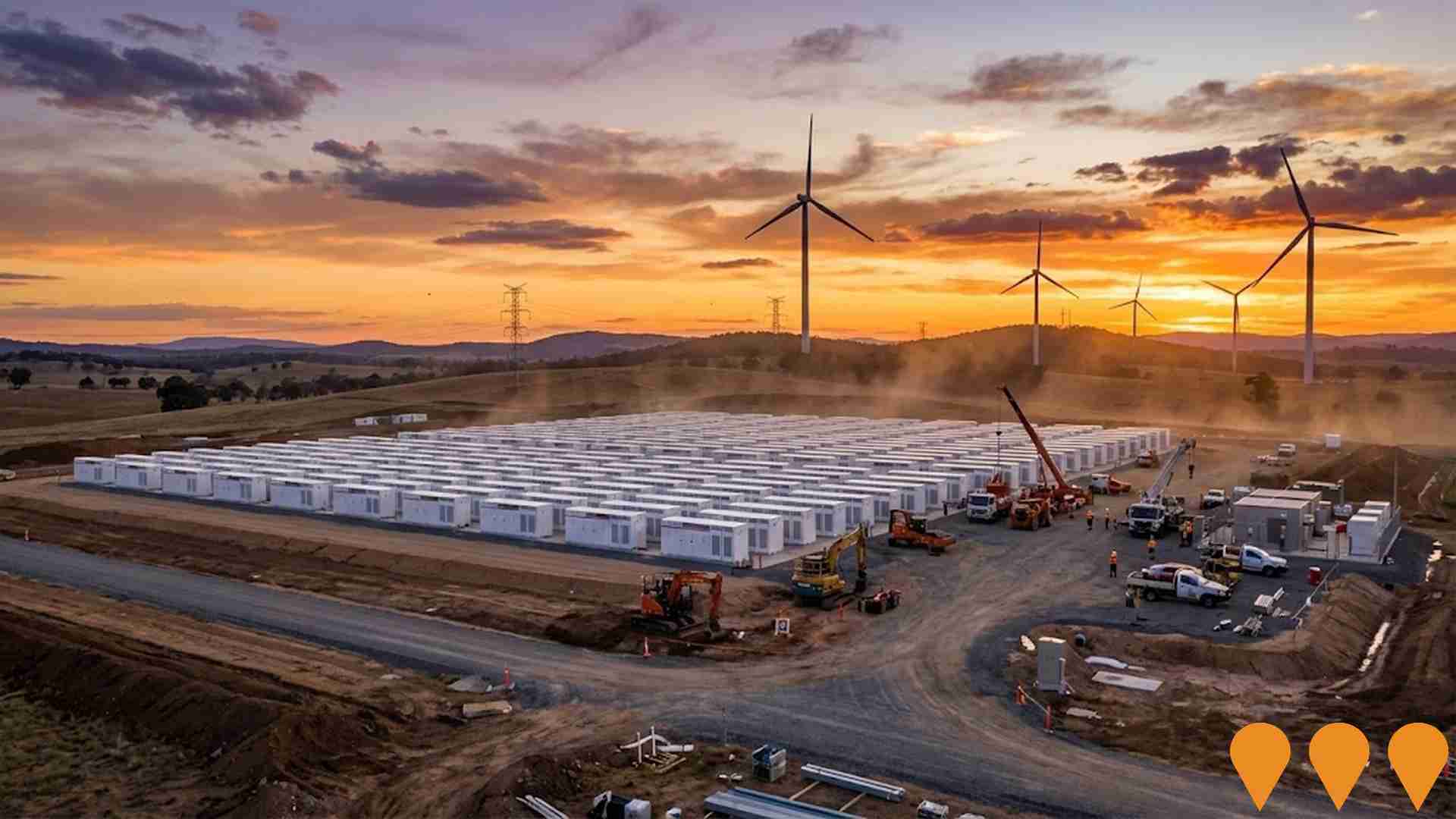
Employment
Chapman ranks among the top 25% of areas assessed nationally for overall employment performance
Chapman has an educated workforce with professional services well represented. Its unemployment rate was 1.7% in June 2025, below the Australian Capital Territory's (ACT) rate of 3.4%.
Employment growth over the past year was estimated at 2.0%. As of June 2025, 1,466 residents were employed with a workforce participation rate of 61.0%, compared to ACT's 69.6%. Major employment sectors include public administration & safety, professional & technical services, and health care & social assistance. Notably, professional & technical services have 1.3 times the regional average employment levels.
Retail trade is under-represented with only 4.1% of Chapman's workforce compared to ACT's 6.6%. Over the year to June 2025, employment increased by 2.0%, labour force grew by 1.6%, and unemployment fell by 0.4 percentage points in Chapman. In contrast, ACT saw employment rise by 1.9% and unemployment fall by 0.3 percentage points. Jobs and Skills Australia's forecasts from May 2025 project national employment growth of 6.6% over five years and 13.7% over ten years. Applying these projections to Chapman's employment mix suggests local growth of approximately 6.8% over five years and 13.7% over ten years, though this is a simple extrapolation for illustrative purposes only.
Frequently Asked Questions - Employment
Income
The economic profile demonstrates exceptional strength, placing the area among the top 10% nationally based on comprehensive AreaSearch income analysis
Chapman's median taxpayer income was $77,996 and average income was $92,788 according to latest postcode level ATO data aggregated by AreaSearch for the financial year 2022. This is notably high compared to Australian Capital Territory's median income of $68,678 and average income of $83,634. By September 2025, estimated median income would be approximately $88,603 and average income $105,407 based on Wage Price Index growth of 13.6% since financial year 2022. In the 2021 Census, Chapman's household, family, and personal incomes ranked highly nationally, between the 97th and 98th percentiles. The largest income segment comprised 37.7% earning $4000+ weekly (1,083 residents), contrasting with the surrounding region where the $1,500 - 2,999 bracket led at 34.3%. Economic strength was evident through 51.6% of households achieving high weekly earnings exceeding $3,000. After housing costs, residents retained 90.6% of income, reflecting strong purchasing power. The area's SEIFA income ranking placed it in the 10th decile.
Frequently Asked Questions - Income
Housing
Chapman is characterized by a predominantly suburban housing profile, with above-average rates of outright home ownership
In Chapman, as per the latest Census evaluation, 89.2% of dwellings were houses, with the remaining 10.8% being other types such as semi-detached homes and apartments. This compares to the Australian Capital Territory's (ACT) figures of 81.7% houses and 18.2% other dwellings. Home ownership in Chapman stood at 48.5%, with mortgaged properties at 39.8% and rented dwellings at 11.7%. The median monthly mortgage repayment in the area was $2,600, higher than ACT's average of $2,251. The median weekly rent figure in Chapman was $450, compared to ACT's $420. Nationally, Chapman's mortgage repayments were significantly higher than the Australian average of $1,863, while rents were substantially above the national figure of $375.
Frequently Asked Questions - Housing
Household Composition
Chapman features high concentrations of family households, with a higher-than-average median household size
Family households constitute 81.7% of all households, including 38.7% couples with children, 33.3% couples without children, and 9.4% single parent families. Non-family households account for the remaining 18.3%, with lone person households at 17.1% and group households comprising 1.2%. The median household size is 2.7 people, which is larger than the Australian Capital Territory average of 2.6.
Frequently Asked Questions - Households
Local Schools & Education
Chapman shows strong educational performance, ranking in the upper quartile nationally when assessed across multiple qualification and achievement indicators
Chapman's educational attainment significantly exceeds national averages. Among residents aged 15+, 52.5% hold university qualifications, compared to Australia's 30.4% and the SA3 area's 46.6%. Bachelor degrees are most common at 29.9%, followed by postgraduate qualifications (15.5%) and graduate diplomas (7.1%). Vocational pathways account for 21.5%, with advanced diplomas at 9.6% and certificates at 11.9%.
Educational participation is high, with 29.9% of residents currently enrolled in formal education. This includes 10.6% in primary, 9.8% in secondary, and 5.2% pursuing tertiary education. Chapman Primary School serves the local area, with an enrollment of 521 students as of a recent report. The school focuses exclusively on primary education, with secondary options available nearby. School capacity exceeds typical residential needs, indicating Chapman serves as an educational center for the broader region.
Frequently Asked Questions - Education
Schools Detail
Nearby Services & Amenities
Transport
Transport servicing is high compared to other areas nationally based on assessment of service frequency, route connectivity and accessibility
Chapman has 19 active public transport stops. These are served by a mix of buses on six different routes. Together, these routes provide 1,211 weekly passenger trips.
The average distance from residents to the nearest stop is 188 meters, indicating excellent accessibility. Each route makes an average of 173 trips per day, which equates to around 63 weekly trips per individual stop.
Frequently Asked Questions - Transport
Transport Stops Detail
Health
Chapman's residents are relatively healthy in comparison to broader Australia with a fairly standard level of common health conditions seen across both young and old age cohorts
Chapman's health metrics closely align with national benchmarks, showing standard levels of common health conditions across both young and elderly cohorts. Approximately 67% (1,929 people) have private health cover, higher than the Australian Capital Territory's 60.9%, and the national average of 55.3%. The most prevalent medical conditions are arthritis (10.1%) and asthma (7.5%).
About 65.9% reported no medical ailments, slightly lower than the Australian Capital Territory's 66.3%. Approximately 25.7% (738 people) are aged 65 and over, higher than the Australian Capital Territory's 20.6%. Seniors in Chapman exhibit strong health outcomes, outperforming the general population in health metrics.
Frequently Asked Questions - Health
Cultural Diversity
The level of cultural diversity witnessed in Chapman was found to be above average when compared nationally for a number of language and cultural background related metrics
Chapman's population showed above-average cultural diversity, with 22.7% born overseas and 12.6% speaking a language other than English at home. Christianity was the predominant religion in Chapman, accounting for 51.4%, compared to 44.9% across Australian Capital Territory. The top three ancestry groups were English (26.9%), Australian (25.5%), and Irish (9.7%).
Notably, Welsh (1.1%) and Hungarian (0.7%) were overrepresented in Chapman compared to regional figures of 0.7% and 0.6%, respectively. Scottish representation was also notable at 8.9%.
Frequently Asked Questions - Diversity
Age
Chapman hosts an older demographic, ranking in the top quartile nationwide
The median age in Chapman is 47 years, significantly higher than the Australian Capital Territory's average of 35 years and Australia's national average of 38 years. Compared to the Australian Capital Territory, Chapman has a higher proportion of residents aged 75-84 (11.2%), but fewer residents aged 25-34 (4.2%). This concentration of residents aged 75-84 is well above the national average of 6%. According to the 2021 Census, the population aged 15-24 grew from 10.9% to 13.8%, while the 75-84 cohort increased from 9.5% to 11.2%. Conversely, the 55-64 age group declined from 13.6% to 12.3%, and the 35-44 age group dropped from 12.2% to 10.9%. By 2041, demographic projections indicate significant shifts in Chapman's age structure. The 85+ age group is expected to grow by 66%, reaching 100 people from 60. Notably, the combined 65+ age groups will account for all of the total population growth, reflecting the area's aging demographic trend. In contrast, both the 75-84 and 0-4 age groups are projected to decrease in numbers.
